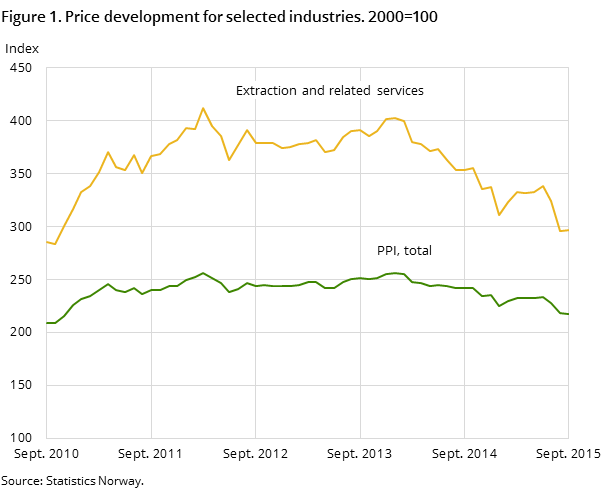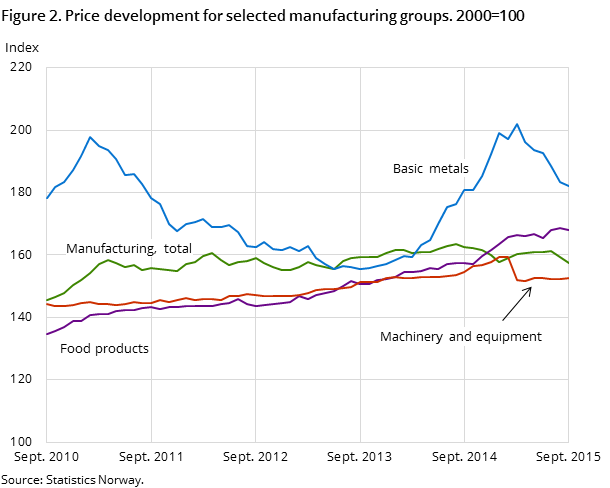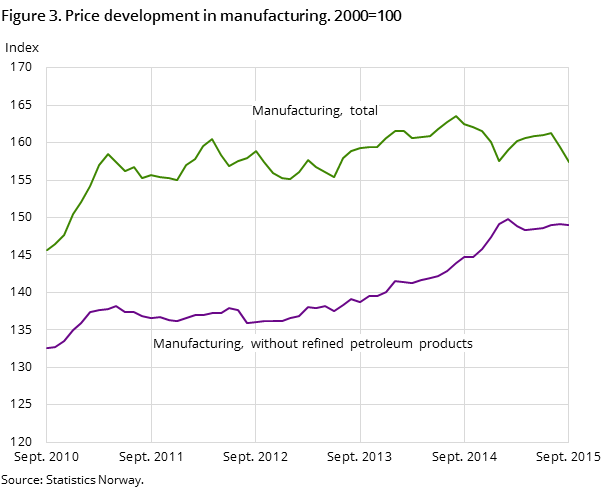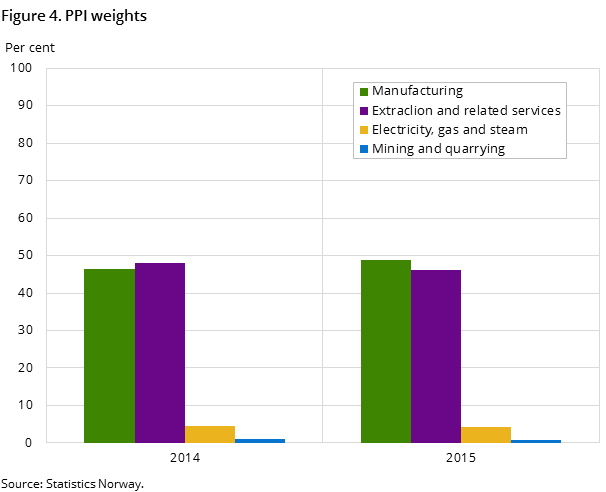Content
Published:
This is an archived release.
Decrease within PPI dampened by higher electricity prices
A reduction in prices within refined petroleum products pulled the producer price index down from August to September. Higher electricity prices on the other hand dampened the total decrease in the PPI and created minimal changes in the total index from last month.
| Industrial Classification | Index change in per cent | Index | Weights1 | |
|---|---|---|---|---|
| August 2015 - September 2015 | September 2014 - September 2015 | |||
| 1The weights are updated annually, and are valid for the entire year. | ||||
| Extraction, mining, manufacturing and electricity | -0.2 | -10.1 | 217.4 | 1 000.0 |
| Extraction and related services | 0.2 | -16.2 | 296.3 | 460.7 |
| Mining and quarrying | 0.2 | 0.9 | 175.9 | 9.0 |
| Manufacturing | -1.2 | -3.1 | 157.5 | 488.6 |
| Food products | -0.4 | 6.7 | 167.9 | 99.6 |
| Refined petroleum products | -6.7 | -27.4 | 168.0 | 86.9 |
| Basic metals | -0.6 | 0.8 | 182.1 | 39.1 |
| Machinery and equipment | 0.1 | -1.2 | 152.5 | 52.8 |
| Electricity, gas and steam | 12.0 | -28.3 | 175.6 | 41.7 |




The PPI fell by 0.2 per cent from August to September. The main reason behind the price decline was a 6.7 per cent price drop within refined petroleum products.
Several other manufacturing groups had lower prices than the month before. One of these groups was food products, where prices fell by 0.4 per cent, mainly due to lower prices on meat and fish products.
Prices within other manufacturing groups only had small changes in September.
Electricity dampened the decrease in the total index
The overall drop in the PPI was dampened by a 12 per cent rise in electricity prices, causing only a small change in the total index from last month. Both the spot price from Nord Pool and the price on electricity sold to Norwegian households rose from August to September, with the spot price increasing 35 per cent. The change in electricity prices was nearly the same as in August.
From September 2014 to September 2015, the PPI fell by 10.1 per cent, mainly due to lower prices within extraction of oil and gas as well as refined petroleum products.
Higher domestic prices and lower export prices
Prices on domestic goods increased from August to September, while export prices fell during the same period. One of the reasons is that electricity has a different impact in the two markets, and higher electricity prices affected the domestic market more than the export market. In addition, crude oil and natural gas played an important role in the difference. The index for extraction of oil and natural gas has different figures for the domestic and export markets. This can be explained by a 2.9 per cent increase in the price of crude oil, which had the greatest impact on the domestic market. A price fall for natural gas governed the export index for extraction of oil and natural gas.
Additional information
Contact
-
Producer price index
E-mail: produsentpris@ssb.no
tel.: (+47) 21 09 40 00
-
Elisabeth Mælum
E-mail: elisabeth.maelum@ssb.no
tel.: (+47) 97 01 28 49
-
Morten Madshus
E-mail: morten.madshus@ssb.no
tel.: (+47) 40 90 26 94
-
Monika Græsli Engebretsen
E-mail: monika.graesli.engebretsen@ssb.no
tel.: (+47) 40 90 23 71
-
Håvard Georg Jensen
E-mail: havard.jensen@ssb.no
tel.: (+47) 40 90 26 86
